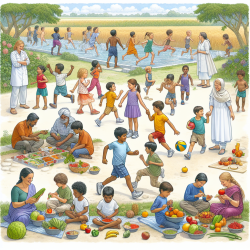Introduction
As practitioners dedicated to improving the lives of children, understanding the unique challenges faced by immigrant children is crucial. The recent research titled "Assessing Quality of Life in First- and Second-Generation Immigrant Children and Adolescents; Highlights from the DIATROFI Food Aid and Healthy Nutrition Promotion Program" provides valuable insights into the health-related quality of life (HRQoL) of immigrant children in Greece. This study reveals significant disparities in the quality of life between immigrant and non-immigrant children, emphasizing the need for targeted interventions.
Key Findings
The study analyzed data from the DIATROFI Program, which supports students in Greece with healthy meals and promotes better dietary habits. It found that both first- and second-generation immigrant children experience poorer HRQoL compared to their non-immigrant peers. Specifically, first-generation immigrants showed more pronounced deficits in physical, social, and school functions.
Key statistics from the study include:
- First-generation immigrant students are 2.82 times more likely to have poor HRQoL compared to non-immigrant students.
- Second-generation immigrant students are 1.68 times more likely to experience poor HRQoL.
- Both first- and second-generation immigrants showed significant challenges in school functioning.
Implications for Practitioners
For practitioners, these findings underscore the importance of culturally sensitive interventions. Here are some strategies to consider:
- Holistic Assessment: Use comprehensive assessment tools that consider cultural and socioeconomic factors when evaluating immigrant children.
- School-Based Interventions: Implement programs within schools to address the specific needs of immigrant children, focusing on enhancing social integration and academic support.
- Parental Engagement: Engage with parents to provide resources and support that can improve the home environment and parental involvement in education.
Encouraging Further Research
While the DIATROFI Program provides a wealth of data, further research is needed to explore the long-term impacts of immigration on children's quality of life. Practitioners are encouraged to contribute to this growing field by conducting longitudinal studies and sharing findings with the broader community.
Conclusion
The DIATROFI Program highlights critical areas where practitioners can make a difference in the lives of immigrant children. By implementing targeted interventions and engaging in further research, we can work towards reducing disparities and enhancing the quality of life for these vulnerable populations.
To read the original research paper, please follow this link: Assessing Quality of Life in First- and Second-Generation Immigrant Children and Adolescents; Highlights from the DIATROFI Food Aid and Healthy Nutrition Promotion Program.










